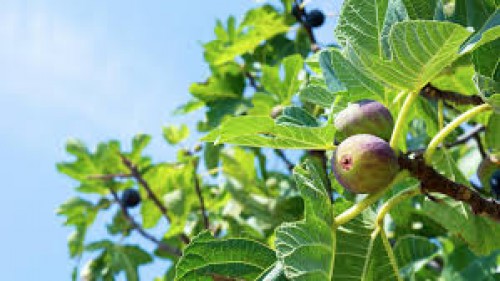off
-
Sold
-

out
Fig (Anjeer) Plant: Care, Advantages & Nature
The Fig (known as Anjeer in many languages) is a fruit-bearing tree or shrub that has been cultivated for thousands of years. Known for its sweet, soft, and nutrient-dense fruit, the fig plant is an important crop in many parts of the world, especially in Mediterranean regions and Asia. Fig trees are well-known for their wide, lobed leaves and distinctively sweet fruits, which are consumed both fresh and dried for their rich flavor and numerous health benefits.
Care of the Fig (Anjeer) Plant
Growing a healthy fig plant requires a few essential care guidelines to ensure it thrives and produces abundant fruit:
- Climate: Fig trees thrive in warm climates and prefer temperatures between 70°F to 100°F (21°C to 38°C). They are ideal for Mediterranean or subtropical climates with long, hot summers and mild winters.
- Soil: Figs grow best in well-drained, slightly acidic to neutral soil. They prefer sandy loam or loamy soils with good water retention capacity but should not sit in waterlogged conditions. The soil should be rich in organic matter.
- Watering: Fig plants require regular watering, especially during dry periods. However, over-watering can lead to root rot. Water the plant deeply but allow the soil to dry out between waterings. Once established, figs are somewhat drought-tolerant.
- Fertilization: Fig trees benefit from an annual application of organic compost or a balanced fertilizer to support strong growth and fruit production. Fertilize during the growing season (spring through summer) to ensure healthy growth.
- Pruning: Regular pruning helps maintain the tree's shape, remove dead or damaged branches, and improve airflow. Prune the fig tree in late winter or early spring before new growth begins, especially if it is growing too large or requires shaping.
- Pest & Disease Control: Fig trees are generally resistant to many pests, but they can occasionally face issues with aphids, scale insects, or fungal diseases. Treat infestations with organic pesticides like neem oil or remove infected branches to keep the tree healthy.
Advantages of the Fig (Anjeer) Plant
- Rich Nutritional Profile: Figs are high in essential nutrients, including dietary fiber, potassium, magnesium, vitamins A and K, and antioxidants. They support digestive health, heart function, and overall well-being.
- Health Benefits: Figs are known for their health-promoting properties. They help regulate blood sugar levels, improve digestion, promote heart health, and support bone health due to their calcium and magnesium content.
- Natural Sweetener: Figs are naturally sweet, making them an excellent alternative to refined sugars in recipes. They can be eaten fresh, dried, or used in smoothies, jams, and baked goods.
- Easy to Grow: Fig trees are relatively low-maintenance once established. They are drought-tolerant and can adapt to a variety of soil conditions. This makes them an excellent option for home gardeners or farmers looking for a hardy and productive fruit tree.
- Versatile Uses: The fruit can be eaten fresh or dried, and the leaves can be used for medicinal purposes. Figs are often used in cooking, baking, jams, and salads, or enjoyed on their own as a healthy snack.
- Ornamental Beauty: Fig trees have a unique, wide-leafed appearance that adds ornamental value to gardens. Their large, green leaves and attractive growth habit make them an eye-catching addition to landscaping projects.
Nature of the Fig (Anjeer) Plant
The Fig tree is a deciduous plant that can grow as a shrub or a small tree, reaching up to 10–30 feet (3–9 meters) in height. Its broad, deeply lobed leaves provide a lush, tropical appearance. Fig trees produce large, green or purple fruits that ripen in late summer to fall, with a sweet, juicy interior filled with numerous tiny seeds.
Fig trees are typically grown for their fruits, but their foliage also makes them an attractive addition to gardens and landscapes. The leaves have a unique shape and are often used in herbal medicine, while the fruit is a popular snack, often consumed dried for preservation.
Figs require a warm, sunny location to thrive, as they are sensitive to cold temperatures and frost. They are best grown in areas with minimal frost and mild winters. The tree’s root system is extensive, so it needs space to grow freely. Once the tree reaches maturity, it produces fruit for many years, often with multiple harvests each season.
Fig trees can be grown in containers, making them suitable for patios, balconies, or smaller gardens. With their long lifespan, fig trees are a great investment for both home gardeners and commercial growers, yielding fruit over many years if cared for properly.
Conclusion
The Fig (Anjeer) plant is a highly beneficial and versatile fruit tree that provides numerous health advantages while offering ornamental value for gardens. Whether you're growing it for its delicious fruit, as a natural sweetener, or for its lush foliage, the fig tree is a rewarding choice for gardeners and fruit enthusiasts. With proper care, a fig tree can continue to provide you with delicious, nutrient-packed fruits for many years to come.